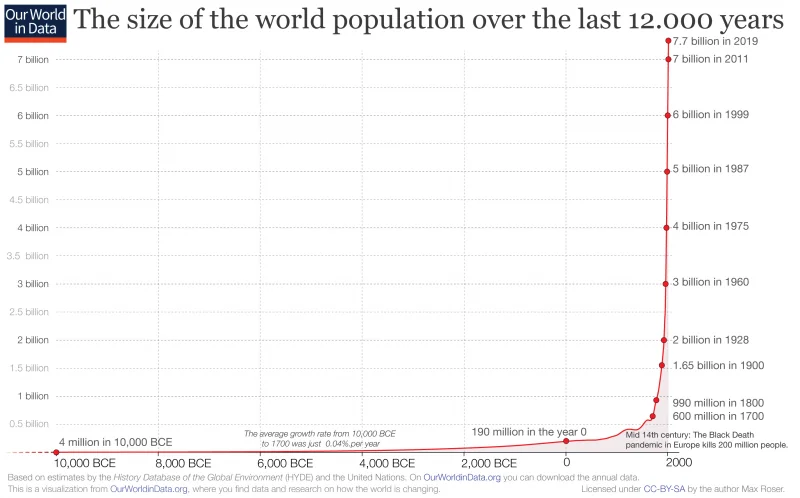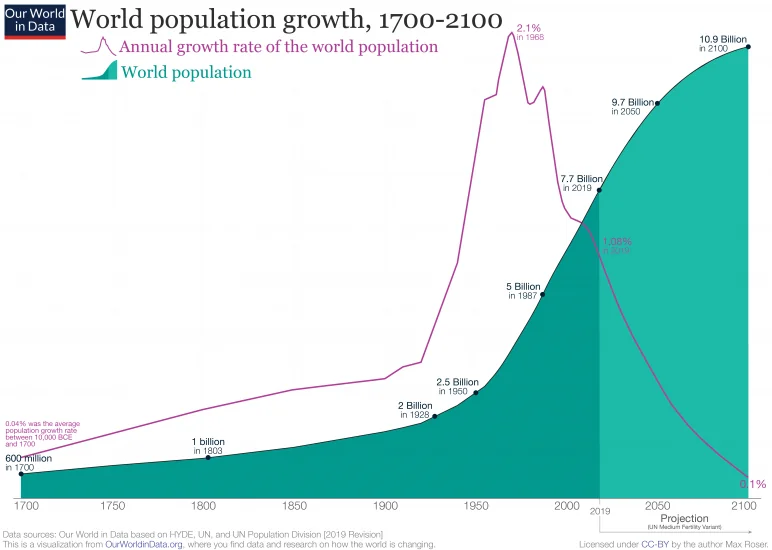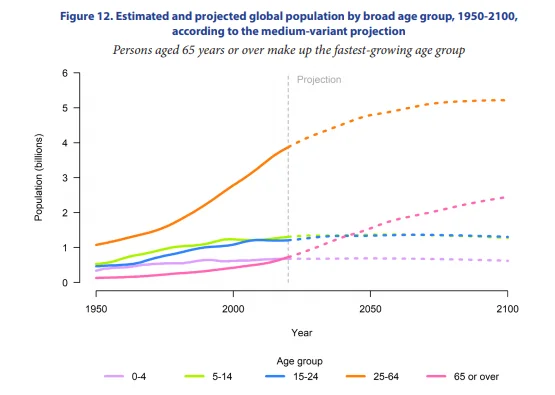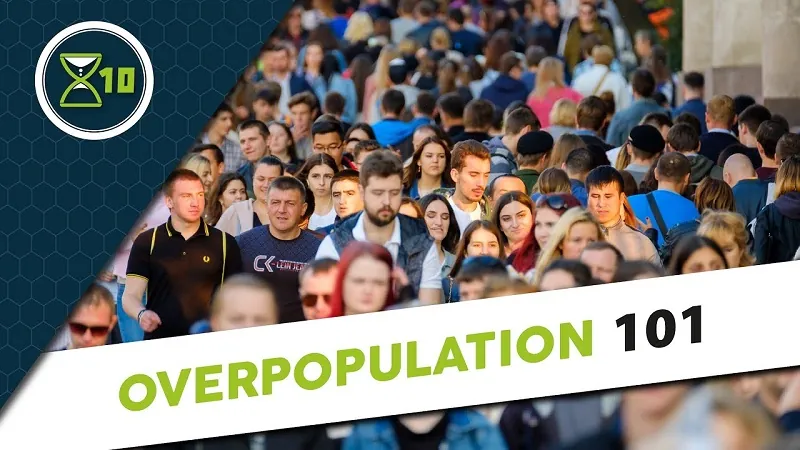In this episode of X10, Nicola describes the commonly cited challenge of overpopulation and why it isn’t the problem that many people think it is.
Script
Famine. Scarcity. Climate instability. Widespread pollution. Lack of fresh water. Global economic and ecological collapse. Billions upon billions of mouths to feed and nowhere near enough resources to do it.
This apocalyptic image is pretty much the worst overpopulation scenario you can think of. Some people are worried that we may be well on our way there already and that unless we reduce our population, we won’t be able to avert a global crisis. So, it’s not a big surprise that these same people, and others too, aren’t exactly crazy about therapies that may extend human life.
But we’re not talking about extending just life, we’re also talking about health. Therapies that might slow down or even reverse aging and keep us fully youthful, healthy, and alive for a seriously long time are in the works, and while people may appreciate the upsides of that, a lot of them are worried about the potential downsides.
And what’s the most obvious downside of a very long-lived population? That’s right—overpopulation. On this planet, we’re having our fair share of environmental concerns as it is; if therapies against aging make us live a lot longer, would this lead to a population catastrophe?
Welcome to X10, your one-stop YouTube show for all things life extension. If this is your first time here, click the subscribe button to follow our channel, and don’t forget to hit the bell icon and choose “All notifications” so that you won’t miss a single episode.
Broadly speaking, you have overpopulation when you don’t have enough resources to support all the individuals in a population. At the very least, this means a diminished quality of life for part or the entirety of the population; depending on the severity of the problem, it may also mean mass starvation, death, and extinction.
This definition of overpopulation only takes into account resource depletion: too many wolves will eat too many bunnies faster than the bunnies can make more bunnies; the well-fed wolves will reproduce even more, eat more bunnies even faster, until eventually there won’t be enough bunnies to feed all the wolves, which will begin to starve. This is more or less the essence of the problem for species in the wild and for the human species too, or at least it was for most of our history.
Nineteenth-century English scholar Thomas Malthus was one of the most well-known thinkers of relatively modern times who discussed overpopulation. In his view, human populations followed the same pattern as any other animal species, and as long as there was abundance, they would just grow and grow; eventually, population growth would outpace food production, and one day there would no longer be enough food for the whole of humanity. According to Malthus, the only way around this is to impose limits on reproduction.
In more modern times, biologist Paul Ehrlich took overpopulation concerns several steps further. In his 1968 book The Population Bomb, he predicted that hundreds of millions of people would starve to death in the 70s and that the dire consequences of overpopulation could at best be mitigated but not fully prevented. That didn’t happen, but it is true that some human activities have negative consequences on the planet, and this may well endanger our own survival.
This is where human overpopulation differs from others. Survival may be endangered when a population grows too large for the environment to sustain but also when something alters the environment, making it less capable of supporting existing populations. The dinosaurs didn’t die off because their population grew too large; they died off because the asteroid that hit the Earth 65 million years ago made their environment unable to sustain them.
Human overpopulation is a bit of both, even though we don’t have it nearly as bad as the dinos did. It’s not just about how much we eat: our lifestyle, our habits, and some of our technologies are changing our environment and our climate. As our population grows, we don’t just consume more resources: we waste more and we pollute more, which makes the planet less suitable not just for our life form but to others too.
In our case, overpopulation is very multifaceted. While the most immediate concern might be if we have enough space where to put all the newcomers, others are more complex. Take food, for example: it’s not just about whether we have enough of it for everybody, but also, possibly most importantly, the impact that producing enough food for the whole population may have on the environment.
As more people are born, we may need to farm more livestock, which means more greenhouse gases, which contributes to climate change; we may need to cut more trees to make room for new pastures and crops, which also plays a role in global warming and destroys the habitat of other species. Pesticides to keep pests away from crops can pollute soil and water, kill species they weren’t intended to, and be toxic to ourselves too; and the more stuff we need to grow, the more crops we’ll have to protect with pesticides. And, of course, to grow more food, we’ll need more water, which may exacerbate a scarcity problem we already have.
The way we’ve been growing food until now might be sustainable until the population doesn’t grow beyond a certain size, but what happens after that point? And that’s not all: what about the economics of a larger population? Our economy revolves around people’s labor, and having a job is pretty much essential to survive at this point. If our population keeps growing, will there be enough jobs for everybody? What if too many people will need a pension, or other forms of social security?
Circling back to our original question, is life extension going to make all of this worse? After all, if everybody lived longer, our population would grow faster and push on the gas pedal of whatever sustainability problem we may have.
This is a very complicated question that can’t be answered in a single episode. Before we can even attempt to discuss it, there’s a simpler one that we need to answer first: what’s the demographic situation like right now, and how did we get there?
Human population growth wasn’t always very fast: it took us 10,000 years to hit a meagre 190 million people, from 10,000 BCE to year zero. From that point on, growth sped up, leading to a total of about 600 million around the year 1700, but from 10,000 BCE to the 1700s, the average growth rate of the human population was only around 0.04% each year.
Around 1800, the human race hit its first billion people, and from there, the numbers began skyrocketing: we reached the second, third, fourth, fifth, and sixth billions in the 1900s alone, and in 2019 we got to 7.7 billion.

This can be explained considering that, in ancient times, child mortality was likely a lot higher than it is today: hygiene and working medicine weren’t really a thing, while famines and plagues were. In the past, one more child meant one more pair of working hands that could help support the family, so families had every reason to make many babies to begin with, and even more so considering that they had to make up for the children that they would likely lose at a tender age.
Technological and scientific progress didn’t really start to pick up until the industrial revolution, so until then, high fertility and high mortality kept each other more or less in check, leading to excruciatingly slow population growth.
As living conditions improved, overall mortality began to fall and so did child mortality, but people didn’t adapt overnight, and kept having a high number of babies. This means there was a relatively long phase with high birth rates and falling mortality, which pushed up the global population growth rate.
Indeed, the world population growth rate was at its highest in the 1960s, when it hit about 2.1%. Since then, it has been plummeting: right now, it’s around 1.08%, and it’s projected to keep falling down to 0.1% in 2100.

With the exception of Africa, the growth rate of individual continents isn’t especially high either: in 2015, the growth rate of most regions of Asia was between 0 and 2 percent; in Oceania it was between 1 and 2 percent; in North and South America it was between 0 and 1 percent, and in Europe it was between -2 percent and 1 percent, which means that in some regions of Europe, population was shrinking, not growing. The growth rate of Africa was between 2 and 4 percent, though that too is projected to go down.
The age breakdown in 2015 saw people between the ages of 25 and 64 as the largest bracket, with 3.65 billion people, followed by children aged 5 to 14 at 1.26 billion. Young people between 15 and 24 years old were the third largest group, with 1.19 billion people, followed by children under 5 years of age, of which there were roughly 674 million, and the over 65s with just under 612 million people.
In 2019, the over 65s overtook the under 5s, and they’re projected to overtake both the 5-14 and the 15-24 brackets by the late 2040s, making them the fastest-growing age group.

This is how the United Nations expect the shape of the population pyramid to change over the next 80 years: the colored bars reflect the medium-variant scenario, which is what the UN thinks will most likely happen, while the grey bars show how much this scenario might be underestimating or overestimating the actual size of each age bracket.
Whichever scenario actually pans out, we’re pretty much guaranteed to end up having a much larger fraction of elderly people than we do today, and that’s a challenge, and not just because there might not be enough working-age people to support them. A larger elderly population means more people with chronic, age-related diseases requiring special care.
If, by that time, we have rejuvenation therapies that can restore the health of the elderly back to what it was in youth, or even delay age-related diseases by a decade, we could dodge a serious healthcare crisis. Either way, the question is: could the additional longevity caused by these therapies lead to overpopulation, and if so, what can we do about it? We’ll try to answer this and other questions in the next overpopulation episode of X10.
Thank you very much for watching this episode! We worked hard to produce it, so if you liked it, it would be great if you could give it a like or leave a comment to say what you liked about it. If you didn’t like it, or have feedback of any kind, you could also leave a comment to let us know.
If you want to help us produce more episodes like this one, you can do so by becoming a Lifespan Hero. The donations of the Lifespan Heroes keep X10 alive along with all other Lifespan.io initiatives to popularize life extension and speed up the defeat of aging.
Finally, If you’re new on our channel and life extension interests you, consider subscribing! If you do, don’t forget to click the bell icon and select “All notifications” to make sure you stay up to date with all we publish. Take care, and see you next time.



